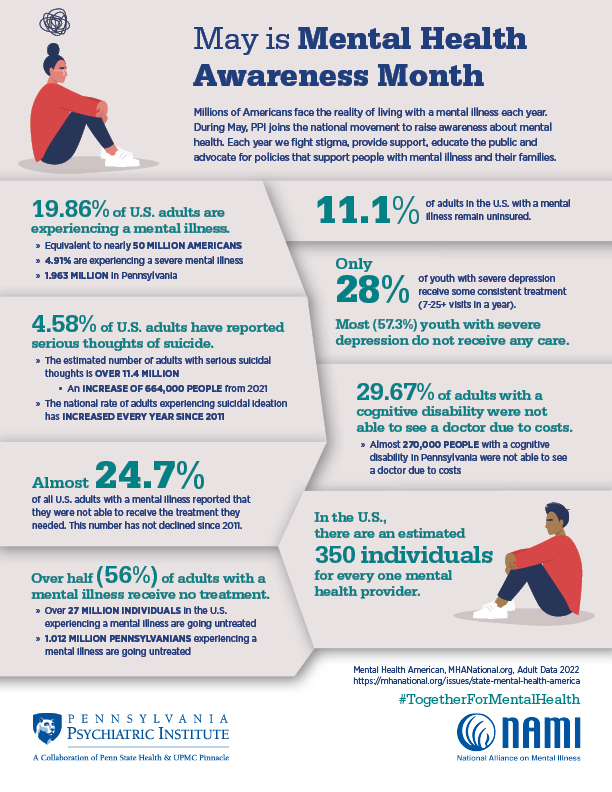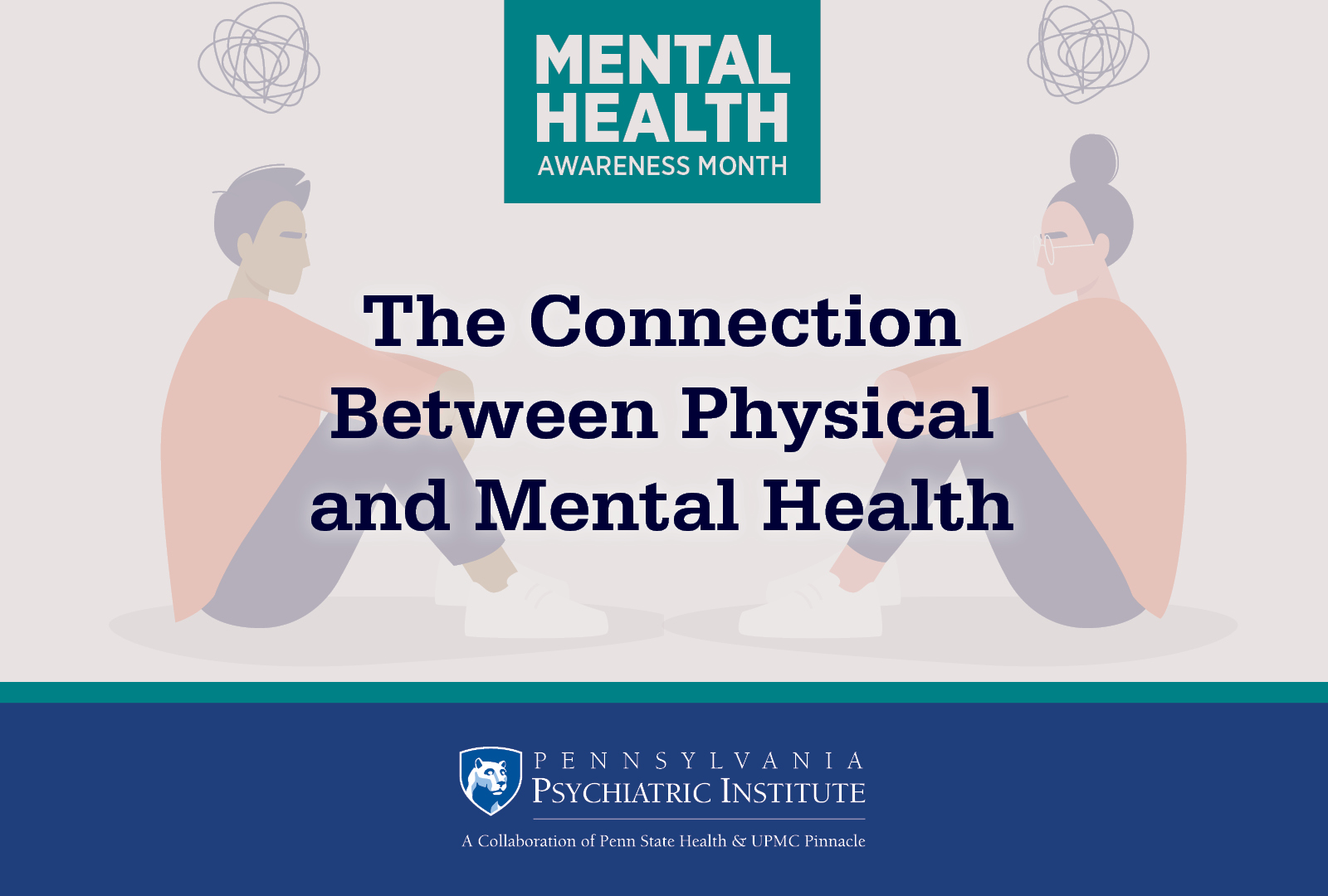May is Mental Health Awareness Month, a time when we recognize the importance of maintaining our mental well-being and supporting those who may be struggling with mental health issues. At the Pennsylvania Psychiatric Institute (PPI), we understand that taking care of our mental health is just as crucial as taking care of our physical health. In fact, there is a strong connection between the two, and by focusing on exercise, nutrition and sleep, we can significantly improve our overall well-being.

The Relationship Between Physical and Mental Health
There is growing evidence that our physical health directly impacts our mental well-being. A healthy body can support a healthy mind, making managing stress, anxiety and other mental health concerns easier. Conversely, poor physical health can lead to a decline in mental well-being. Chronic illnesses, obesity and inactivity can all contribute to an increased risk of depression, anxiety and other mental health disorders.
Exercise: Boosting Both Body and Mind
Exercise has long been known to improve physical health, but its impact on mental health is equally important. Engaging in regular physical activity can reduce symptoms of depression and anxiety, improve mood and increase self-esteem. Exercise also promotes the release of endorphins – the body’s natural mood elevators – and other neurotransmitters that help regulate mood and decrease stress.
Aim for at least 150 minutes of moderate-intensity aerobic exercise or 75 minutes of vigorous-intensity aerobic exercise per week, along with muscle-strengthening activities two or more days per week. Choose activities you enjoy, like walking, swimming or yoga, to make exercise a sustainable and enjoyable part of your daily routine.
- A simple yet effective form of exercise, brisk walking can be done outdoors in your neighborhood, at a nearby park or even indoors at a shopping mall. Aim for a pace that increases your heart rate and makes you breathe harder, but still allows you to carry on a conversation.
- Dancing is a fun way to increase your heart rate and improve cardiovascular fitness. Choose your favorite music and dance in the comfort of your own home or join a community dance class to enjoy the social aspect of this enjoyable exercise.
- Running or jogging is a high-impact exercise that significantly increases your heart rate and offers a vigorous aerobic workout. You can run outdoors on sidewalks, trails or parks or even perform high-intensity interval training (HIIT) by alternating between running and walking to maximize the benefits.
- Jumping jacks, the classic calisthenic exercise, is an excellent way to engage in vigorous aerobic activity without any equipment. To perform jumping jacks, stand with your feet together and hands by your sides, then jump your feet out to the sides and simultaneously raise your arms above your head. Jump your feet back together and lower your arms to complete one repetition. Perform multiple sets of jumping jacks with short breaks in between for a vigorous workout.
- Squats are an effective lower body exercise that primarily targets your quadriceps, hamstrings and glutes. To perform a bodyweight squat, stand with your feet shoulder-width apart and your toes pointing slightly outwards. Bend your knees and lower your hips as if sitting in an imaginary chair, keeping your chest up and your knees aligned with your toes. Push through your heels to return to the starting position. Repeat multiple sets and repetitions to strengthen your leg muscles.
- Push-ups are a versatile upper body exercise that targets your chest, shoulders and triceps. Begin in a plank position with your hands slightly wider than shoulder-width apart and your body in a straight line from your head to your heels. Lower your body by bending your elbows, keeping them close to your body, until your chest is just above the ground. Push yourself back to the starting position, maintaining a strong core throughout the movement. Modify push-ups by performing them on your knees or against a wall if needed.
What we eat also plays a significant role in our mental health. A balanced diet, rich in whole foods, lean proteins, healthy fats and plenty of fruits and vegetables, provides the nutrients necessary for optimal brain function and emotional well-being. A poor diet, on the other hand, can exacerbate mental health issues and contribute to feelings of lethargy, irritability and poor concentration.
To support both physical and mental health, aim for a balanced diet that includes a variety of nutrient-dense foods. Prioritize lean proteins, whole grains, healthy fats, and colorful fruits and vegetables, and limit processed foods and added sugars.
Visit MyPlate.gov, provided by the U.S. Department of Agriculture, to find resources to help plan healthy meals and stay within a budget. For example, MyPlate offers the Shop Simple app to help “find savings in your area and discover new ways to prepare budget-friendly foods.”
Sleep: The Foundation of Health and Well-being
Quality sleep is essential for both physical and mental health. A consistent sleep schedule and getting the recommended 7 to 9 hours of sleep per night can help improve mood, concentration and overall well-being. Insufficient sleep can contribute to depression, anxiety and other mental health disorders and impair our ability to manage stress.
To improve sleep quality, establish a regular sleep schedule, create a relaxing bedtime routine and ensure your sleep environment is dark, quiet and comfortable. Limit screen time before bed and avoid caffeine and alcohol close to bedtime to help your body prepare for restful sleep.
How much sleep do you need?
- Adults need 7 or more hours each night
- Teens need 8 to 10 hours of sleep each night
- School-aged children need 9 to 12 hours of sleep each night
- School-aged children need 9 to 12 hours of sleep each night
- Preschoolers need to sleep between 10 and 13 hours a day (including naps)
- Toddlers need to sleep between 11 and 14 hours a day (including naps)
- Babies need to sleep between 12 and 16 hours a day (including naps)
- Newborns need to sleep between 14 and 17 hours a day
*U.S. Department of Health and Human Services, Office of Disease Prevention and Health Promotion (link)
Focusing on exercise, nutrition and sleep can nurture the connection between physical and mental health and create a strong foundation for overall well-being. As we recognize Mental Health Awareness Month, let’s make a commitment to prioritize these key aspects of our health and encourage those around us to do the same. With a healthy body and mind, we are better equipped to handle life’s challenges and support the mental well-being of ourselves and our loved ones.
PPI is available to help. Visit PPImhs.org or call 1 (866) 746-2496, available 24 hours a day, seven days a week, to schedule an appointment.

